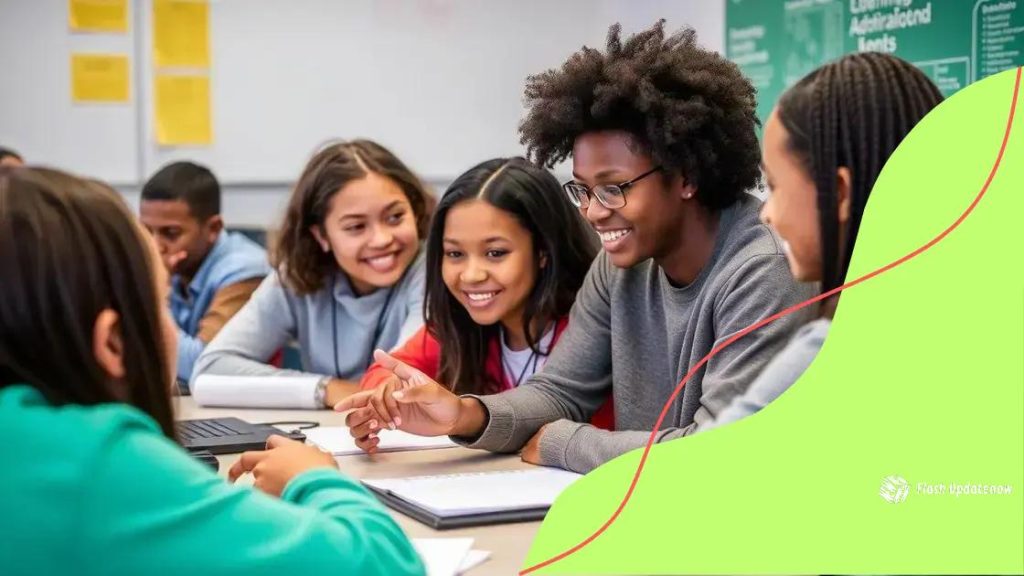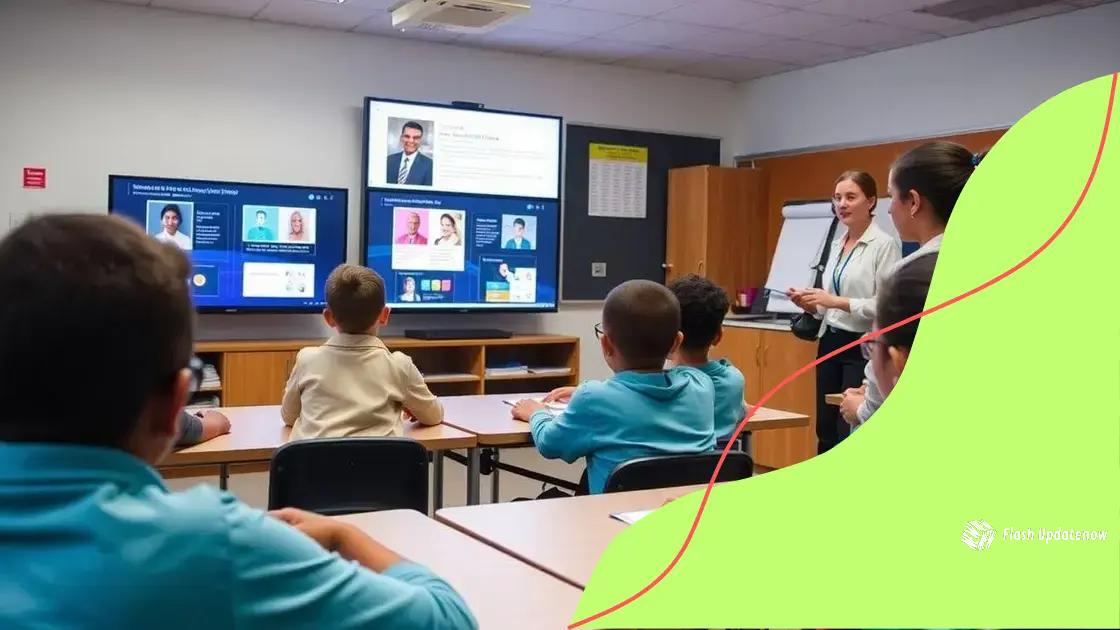AI-driven personalized tutoring for refugee students

AI-driven personalized tutoring for refugee students in urban schools enhances individualized learning, supports diverse educational needs, and offers opportunities for teachers to engage more effectively while addressing challenges like data privacy and equity.
AI-driven personalized tutoring for refugee students could be a game-changer in urban schools, addressing unique learning needs effectively. Have you considered how tailored approaches can bridge educational gaps?
Understanding the role of AI in education
Understanding the role of AI in education is crucial as technology continues to evolve. AI can offer tailored learning experiences that meet individual student needs, particularly for refugee students.
This innovative approach is not just about automating tasks; it’s about enhancing the educational journey. For instance, adaptive learning systems can analyze a student’s progress and adjust the curriculum accordingly.
Benefits of AI in the Classroom
When we think about AI in education, we must consider the various benefits it brings:
- Personalization: AI helps create customized learning paths for each student.
- Immediate Feedback: Students receive real-time insights into their performance.
- Identification of Struggles: AI can quickly pinpoint areas where students may need extra help.
- Engagement: Interactive AI tools can make learning more engaging for students.
Moreover, AI can enhance teacher effectiveness. By automating administrative tasks, teachers can focus more on instruction and personal interaction with students. They can utilize data provided by AI tools to understand better how to support their students, particularly those coming from diverse backgrounds.
As we explore more uses of AI, it’s clear that it unlocks opportunities for refugee students who may face linguistic or cultural barriers. AI tutors can provide language support and adapt content for varied comprehension levels. This way, every student can find their footing in a new educational environment.
Challenges and Considerations
Despite its potential, the integration of AI in education also presents challenges. Schools must consider:
- Data Privacy: Safeguarding students’ information is crucial.
- Equity: All students must have access to AI tools.
- Training: Educators need proper training to use AI effectively.
In summary, the understanding of the role of AI in education encompasses vast possibilities and challenges. By leveraging AI thoughtfully, we can enhance learning experiences for all students, particularly those with unique needs.
How personalized tutoring helps refugee students
Personalized tutoring plays a vital role in supporting refugee students. This approach takes into account their unique backgrounds, challenges, and learning styles, ensuring that each student receives the attention they need to thrive.
For refugee students, educational experiences may vary greatly from their peers. Personalized tutoring can help bridge the gap. It allows tutors to adapt lessons that respond to individual needs, whether they require support in language acquisition or subject-specific assistance.
Key Benefits of Personalized Tutoring
Some specific benefits include:
- Tailored Learning: Lessons are customized to fit each student’s skill level and pace.
- Improved Language Skills: Refugee students often need extra help with language. Personalized tutoring can provide focused language instruction.
- Cultural Sensitivity: Tutors can be trained to understand and respect cultural differences, enhancing communication and support.
- Building Confidence: One-on-one attention can boost a student’s confidence, making them more willing to participate.
As personalized tutoring structures each lesson around the student’s needs, it fosters a sense of safety and security. This is crucial for students adjusting to new environments and educational systems.
Real-World Examples
In practice, personalized tutoring might involve various adaptive techniques. For instance, tutors often use interactive activities that engage students and make learning fun. Technology can be a powerful ally—platforms that adapt to a student’s progress can enhance their learning experience promote independent work. Moreover, by creating a supportive atmosphere, tutors encourage refugee students to express themselves without fear of judgment.
Additionally, fostering relationships with tutors helps build a community for these students. They can establish connections with mentors who understand their experiences and challenges, creating a sense of belonging
Ultimately, personalized tutoring offers refugee students the chance to not only catch up academically but also gain essential life skills. This approach helps pave the way for their future success.
Practical applications of AI-driven tutoring

AI-driven tutoring has numerous practical applications that greatly enhance the educational experience for students. This technology helps tailor the learning process, making it more engaging and effective for various needs.
One of the key ways AI is applied in tutoring is through adaptive learning platforms. These platforms assess each student’s abilities and learning pace. By analyzing their progress, they can offer personalized content that suits individual requirements. This ensures that every student can learn at their own speed without feeling overwhelmed.
Key Features of AI-driven Tutoring
Some notable features include:
- Personalized Learning Paths: AI systems create unique learning journeys based on individual assessments.
- Data-Driven Insights: Educators can access valuable data on student performance, allowing for informed decision-making.
- Interactive Learning Environments: AI tools can make learning more dynamic through games and interactive exercises.
- 24/7 Availability: Students can access tutoring resources at any time, promoting self-directed learning.
Moreover, AI can significantly assist teachers by automating administrative tasks. This changes the teacher’s role from simply delivering content to actively engaging with students. With less time spent on routine paperwork, educators can focus more on providing support and addressing individual needs.
Examples in Action
For instance, AI-driven tutoring systems are currently used in various subjects. In language learning, AI can evaluate pronunciation and grammar in real-time, offering instant feedback to learners. In mathematics, programs can adjust difficulty levels based on how well a student is grasping concepts. This immediate adaptability makes a significant difference in students’ learning journeys.
Additionally, some platforms use AI chatbots to provide support outside of regular tutoring hours. These bots can answer common questions, guide students through exercises, and provide resources tailored to their level. This level of support is particularly important for refugee students who may require extra help adapting to new educational environments and curricula.
In summary, practical applications of AI-driven tutoring empower students and educators alike, creating a supportive ecosystem for learning.
Challenges faced in implementing AI in schools
Implementing AI in schools presents several challenges that educators and administrators must navigate. These challenges can hinder the effective integration of technology in the classroom.
One significant concern is the issue of data privacy. Schools must protect sensitive student information and ensure compliance with regulations. Parents and guardians often worry about how their children’s data will be used and whether it will be secure.
Resistance to Change
Another challenge is the resistance to change from teachers and staff. Many educators may feel overwhelmed by new technologies or unsure about incorporating them into their teaching methods. Professional development is essential to help teachers understand the benefits of AI and to give them the skills they need to use it effectively.
Equity and Access
Furthermore, equity and access are critical issues in implementing AI. Not all schools have the same resources or technological infrastructure. This discrepancy can create a digital divide, where some students benefit from advanced AI tools while others do not have access to the same opportunities.
Funding can also be a limiting factor. Schools need financial resources to invest in AI technologies and training for teachers. Without sufficient funding, many educational institutions may struggle to adopt new tools that could enhance learning.
Moreover, the rapid pace of technological advancement can be challenging. It can be difficult for schools to keep up with the latest AI developments, leading to outdated tools if they are unable to adapt quickly. Additionally, ethical considerations must be addressed. The potential biases in AI algorithms can impact educational outcomes. Schools must be vigilant in evaluating the tools they use and ensuring they are fair and inclusive.
In conclusion, navigating the challenges of implementing AI in schools demands careful planning and consideration. Schools must prioritize data privacy, overcome resistance to change, ensure equitable access, secure funding, and adopt new technologies thoughtfully.
Future perspectives for AI in urban education
The future of AI in urban education is bright and full of potential. As technology continues to advance, we can expect to see even more innovative tools that will enhance learning experiences for students in urban settings.
One promising trend is the increasing integration of AI into daily classroom activities. AI can provide personalized learning experiences that adapt to the unique needs of each student. This individualized approach is particularly beneficial for diverse urban classrooms, where students may come from varied backgrounds and possess different learning abilities.
Emerging Technologies
Emerging technologies will play a significant role in shaping the future of education. Some aspects to look forward to include:
- Smart Classrooms: Classrooms equipped with AI can analyze student engagement in real time, adjusting lessons accordingly.
- Virtual Assistants: AI tools can aid teachers by helping manage daily tasks, allowing them to focus on student interactions.
- Predictive Analytics: Schools can use AI to predict student performance and identify those who may need additional support.
- Enhanced Collaboration: AI can facilitate team-based learning experiences, encouraging collaboration among students.
Another important perspective is the development of AI-driven languages and translation tools. This is especially relevant for urban schools with diverse student populations, including many non-native speakers. These tools can help break down language barriers, making it easier for students to engage with the curriculum.
Ethical Considerations
However, alongside these advancements, we must also focus on ethical considerations. As AI becomes more prevalent in education, ensuring data privacy and equity in access to technology will be crucial. It’s essential to create systems that serve all students fairly and responsibly.
The collaboration between educators, technologists, and policymakers will be key in shaping this future. By working together, they can create frameworks that promote positive outcomes through the thoughtful integration of AI in urban education.
In essence, the future perspectives for AI in urban education are filled with opportunities to enhance learning, foster inclusion, and support educators in meeting the diverse needs of their students.
FAQ – Frequently Asked Questions about AI in Urban Education
How can AI personalize learning for students?
AI can adapt educational content to meet the unique needs of each student, ensuring they learn at their own pace and style.
What are the main challenges of implementing AI in schools?
Key challenges include data privacy concerns, resistance to change from educators, and the need for equitable access to technology.
In what ways can AI support teachers?
AI can automate administrative tasks, provide insights into student performance, and assist with lesson planning, allowing teachers to focus more on student engagement.
What future opportunities does AI present for urban education?
AI offers opportunities for innovative teaching methods, enhanced student engagement, and tools that can break down language barriers for diverse classrooms.
